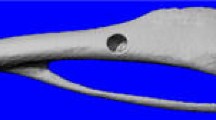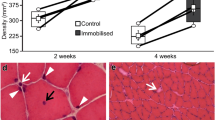Abstract
Studies to date have assumed that botulinum toxin type A (BTX) affects bone indirectly, through its action on muscle. We hypothesized that BTX has no discernable effect on bone morphometry, independent of its effect on muscle. Therefore, we investigated whether BTX had an additional effect on bone when combined with tenotomy compared to tenotomy in isolation. Female BALB/c mice (n = 73) underwent one of the following procedures in the left leg: BTX injection and Achilles tenotomy (BTX-TEN), BTX injection and sham surgery (BTX-sham), Achilles tenotomy (TEN), or sham surgery (sham). BTX groups were injected with 20 μL of BTX (1 U/100 g) in the posterior lower hindlimb. At 4 weeks, muscle cross-sectional area (MCSA) and tibial bone morphometry were assessed using micro-CT. Each treatment, other than sham, resulted in significant muscle and bone loss (P < 0.05). BTX-TEN experienced the greatest muscle loss (23–45% lower than other groups) and bone loss (20–30% lower bone volume fraction than other groups). BTX-sham had significantly lower MCSA and bone volume fraction than TEN and sham. After adjusting for differences in MCSA, there were no significant between-group differences in bone properties. We found that BTX injection resulted in more adverse muscle and bone effects than tenotomy and that effects were amplified when the procedures were combined. However, between-group differences in bone could be accounted for by MCSA. We conclude that any independent effect of BTX on bone morphometry is likely small or negligible compared with the effect on muscle.





Similar content being viewed by others
References
Robling AG (2010) Muscle loss and bone loss: master and slave? Bone 46:272–273
Manske SL, Boyd SK, Zernicke RF (2010) Muscle and bone follow similar temporal patterns of recovery from muscle-induced disuse due to botulinum toxin injection. Bone 46:24–31
Warner SE, Sanford DA, Becker BA, Bain SD, Srinivasan S, Gross TS (2006) Botox induced muscle paralysis rapidly degrades bone. Bone 38:257–264
Poliachik SL, Bain SD, Threet D, Huber P, Gross TS (2010) Transient muscle paralysis disrupts bone homeostasis by rapid degradation of bone morphology. Bone 46:18–23
Grimston SK, Silva MJ, Civitelli R (2007) Bone loss after temporarily induced muscle paralysis by Botox is not fully recovered after 12 weeks. Ann NY Acad Sci 1116:444–460
Lin RC, Scheller RH (2000) Mechanisms of synaptic vesicle exocytosis. Annu Rev Cell Dev Biol 16:19–49
Chen CM, Stott NS, Smith HK (2002) Effects of botulinum toxin A injection and exercise on the growth of juvenile rat gastrocnemius muscle. J Appl Physiol 93:1437–1447
Duchen LW (1970) Changes in motor innervation and cholinesterase localization induced by botulinum toxin in skeletal muscle of the mouse: differences between fast and slow muscles. J Neurol Neurosurg Psychiatry 33:40–54
Alzghoul MB, Gerrard D, Watkins BA, Hannon K (2004) Ectopic expression of IGF-I and Shh by skeletal muscle inhibits disuse-mediated skeletal muscle atrophy and bone osteopenia in vivo. FASEB J 18:221–223
Elefteriou F (2008) Regulation of bone remodeling by the central and peripheral nervous system. Arch Biochem Biophys 473:231–236
Goto T, Kido MA, Yamaza T, Tanaka T (2001) Substance P and substance P receptors in bone and gingival tissues. Med Electron Microsc 34:77–85
Hodges GJ, Jackson DN, Mattar L, Johnson JM, Shoemaker JK (2009) Neuropeptide Y and neurovascular control in skeletal muscle and skin. Am J Physiol Regul Integr Comp Physiol 297:R546–R555
Alam AS, Gallagher A, Shankar V, Ghatei MA, Datta HK, Huang CL, Moonga BS, Chambers TJ, Bloom SR, Zaidi M (1992) Endothelin inhibits osteoclastic bone resorption by a direct effect on cell motility: implications for the vascular control of bone resorption. Endocrinology 130:3617–3624
Verderio C, Grumelli C, Raiteri L, Coco S, Paluzzi S, Caccin P, Rossetto O, Bonanno G, Montecucco C, Matteoli M (2007) Traffic of botulinum toxins A and E in excitatory and inhibitory neurons. Traffic 8:142–153
Malarkey EB, Parpura V (2008) Mechanisms of glutamate release from astrocytes. Neurochem Int 52:142–154
Mason DJ, Suva LJ, Genever PG, Patton AJ, Steuckle S, Hillam RA, Skerry TM (1997) Mechanically regulated expression of a neural glutamate transporter in bone: a role for excitatory amino acids as osteotropic agents? Bone 20:199–205
Spencer GJ, McGrath CJ, Genever PG (2007) Current perspectives on NMDA-type glutamate signaling in bone. Int J Biochem Cell Biol 39:1089–1104
Bhangu PS, Genever PG, Spencer GJ, Grewal TS, Skerry TM (2001) Evidence for targeted vesicular glutamate exocytosis in osteoblasts. Bone 29:16–23
Turner CH, Robling AG, Duncan RL, Burr DB (2002) Do bone cells behave like a neuronal network? Calcif Tissue Int 70:435–442
Skerry TM, Genever PG (2001) Glutamate signaling in non-neuronal tissues. Trends Pharmacol Sci 22:174–181
Beamer WG, Donahue LR, Rosen CJ, Baylink DJ (1996) Genetic variability in adult bone density among inbred strains of mice. Bone 18:397–403
Buie HR, Moore CP, Boyd SK (2008) Postpubertal architectural developmental patterns differ between the L3 vertebra and proximal tibia in three inbred strains of mice. J Bone Miner Res 23:2048–2059
Bouxsein ML, Boyd SK, Christiansen BA, Guldberg RE, Jepsen KJ, Müller R (2010) Guidelines for assessment of bone microstructure in rodents using micro-computed tomography. J Bone Miner Res 25:1468–1486
Luu YK, Lublinsky S, Ozcivici E, Capilla E, Pessin JE, Rubin CT, Judex S (2009) In vivo quantification of subcutaneous and visceral adiposity by micro-computed tomography in a small animal model. Med Eng Phys 31:34–41
Buie HR, Campbell GM, Klinck RJ, MacNeil JA, Boyd SK (2007) Automatic segmentation of cortical and trabecular compartments based on a dual threshold technique for in vivo micro-CT bone analysis. Bone 41:505–515
Hildebrand T, Rüegsegger P (1997) A new method for the model-independent assessment of thickness in three-dimensional images. J Microsc 185:67–75
Hildebrand T, Rüegsegger P (1997) Quantification of bone microarchitecture with the structure model index. Comput Methods Biomech Biomed Eng 1:15–23
Odgaard A, Gundersen HJ (1993) Quantification of connectivity in cancellous bone, with special emphasis on 3-D reconstructions. Bone 14:173–182
Bruns J, Kampen J, Kahrs J, Plitz W (2000) Achilles tendon rupture: experimental results on spontaneous repair in a sheep-model. Knee Surg Sports Traumatol Arthrosc 8:364–369
Lipscomb PR, Wakim KG (1961) Regeneration of severed tendons: an experimental study. Proc Staff Meet Mayo Clin 36:271–276
Elder GC, Toner LV (1998) Muscle shortening induced by tenotomy does not reduce activity levels in rat soleus. J Physiol 512:251–265
Lipscomb PR, Wakim KG (1961) Further observations in the healing of severed tendons: an experimental study. Proc Staff Meet Mayo Clin 36:277–282
Gerber C, Meyer DC, Schneeberger AG, Hoppeler H, von Rechenberg B (2004) Effect of tendon release and delayed repair on the structure of the muscles of the rotator cuff: an experimental study in sheep. J Bone Joint Surg Am 86:1973–1982
McLachlan EM (1981) Rapid atrophy of mouse soleus muscles after tenotomy depends on an intact innervation. Neurosci Lett 25:269–274
Jamali AA, Pouya A, Abrams RA, Lieber RL (2000) Skeletal muscle response to tenotomy. Muscle Nerve 23:851–862
Zeng QQ, Jee WS, Bigornia AE, King JG Jr, D’ Souza SM, Li XJ, Ma YF, Wechter WJ (1996) Time responses of cancellous and cortical bones to sciatic neurectomy in growing female rats. Bone 19:13–21
Yaraskavitch M, Leonard T, Herzog W (2008) Botox produces functional weakness in non-injected muscles adjacent to the target muscle. J Biomech 41:897–902
Sanders DB, Massey EW, Buckley EG (1986) Botulinum toxin for blepharospasm: single-fiber EMG studies. Neurology 36:545–547
Wiegand H, Erdmann G, Wellhoner HH (1976) 125I-labelled botulinum A neurotoxin: pharmacokinetics in cats after intramuscular injection. Naunyn Schmiedebergs Arch Pharmacol 292:161–165
Dressler D, Adib Saberi F (2005) Botulinum toxin: mechanisms of action. Eur Neurol 53:3–9
Burr DB (1997) Muscle strength, bone mass, and age-related bone loss. J Bone Miner Res 12:1547–1551
Prendergast PJ, Van Der Helm FCT, Duda GN (2005) Analysis of muscle and joint loads. In: Mow VC, Huiskes R (eds) Basic orthopaedic biomechanics and mechano-biology. Lippincott Williams & Wilkins, Philadelphia, PA, pp 29–89
Ma J, Elsaidi GA, Smith TL, Walker FO, Tan KH, Martin E, Koman LA, Smith BP (2004) Time course of recovery of juvenile skeletal muscle after botulinum toxin A injection: an animal model study. Am J Phys Med Rehabil 83:774–780 (quiz 781–773)
Gross TS, Poliachik SL, Prasad J, Bain SD (2010) The effect of muscle dysfunction on bone mass and morphology. J Musculoskelet Neuronal Interact 10:25–34
Acknowledgements
We thank Dr. Linda Andersen for performing the surgeries, Adam Wasylyshyn for assistance with data collection, as well as Helen Buie and Christopher Moore for designing the scanning fixture. We also thank Dr. Walter Herzog for feedback on the manuscript. S. L. M. was supported by the Natural Sciences and Engineering Research Council of Canada (NSERC), Alberta Innovates – Health Solutions, and the Killam Trust.
Author information
Authors and Affiliations
Corresponding author
Additional information
The authors have stated that they have no conflict of interest.
Rights and permissions
About this article
Cite this article
Manske, S.L., Boyd, S.K. & Zernicke, R.F. Muscle Changes Can Account for Bone Loss After Botulinum Toxin Injection. Calcif Tissue Int 87, 541–549 (2010). https://doi.org/10.1007/s00223-010-9428-2
Received:
Accepted:
Published:
Issue Date:
DOI: https://doi.org/10.1007/s00223-010-9428-2




